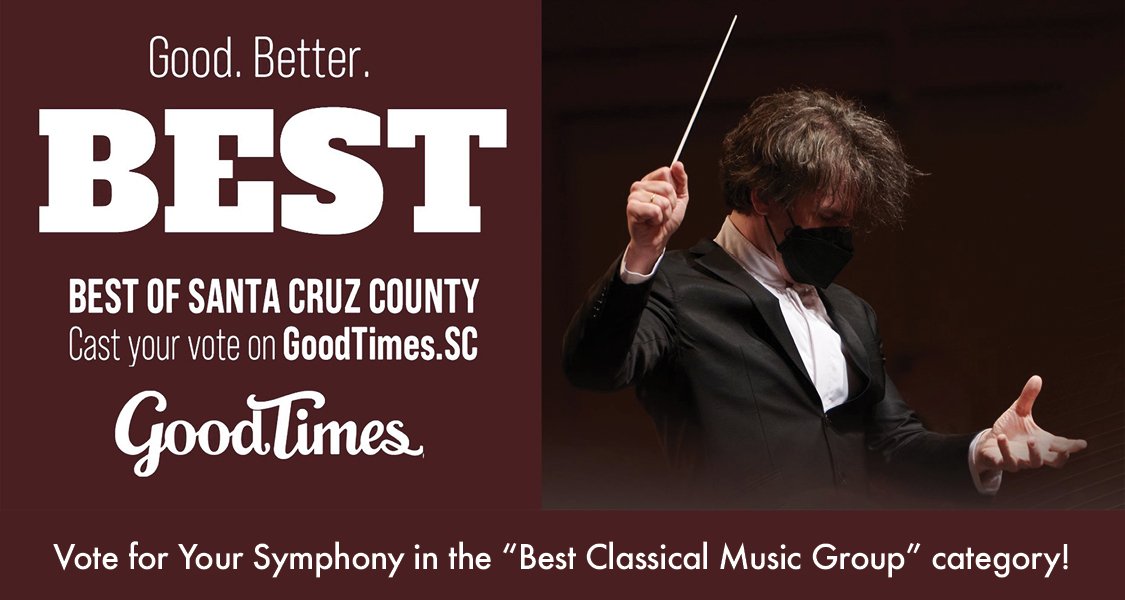Concert supporters enjoy and support Maestro Danny Stewart’s attention to and promotion of contemporary music, new compositions, and the artists who perform them. This is part of the marvelous series he has and continues to present with his highly rated Santa Cruz Symphony. Certainly, Maestro Stewart is to be commended not only for his accomplishments as conductor, but also for the wonderful educational role his programming offers. In one way or another, this concert was a Tour de Force!
On Sunday, January 29 at the Mello Center in Watsonville, the Santa Cruz Symphony opened the new year with Tumblebird Contrails (2014) by Berkeley composer Gabriella Smith (1991). Smith writes: “The title, Tumblebird Contrails, is a Kerouac-inspired nonsense phrase I invented to evoke the sound and feeling of this piece.” Smith continues: “Tumblebird Contrails was inspired by a single moment I experienced while backpacking in Point Reyes, sitting in the sand at the edge of the ocean, listening to the hallucinatory sounds of the Pacific (the keening gulls, pounding surf, rush of approaching waves, sizzle of sand and sea foam in receding tides), the constant ebb and flow of pitch to pitchless, tune to texture, grooving to free-flowing, watching a pair of ravens playing in the wind, rolling, swooping, diving, soaring, imagining the ecstasy of wind in the wings, jet trails painting never-ending streaks across the sky.”
In essence, this work is daring, galvanizing, and by all means certainly worth experiencing.
In this case, it is orchestral music that amounts to “program music” depicting extra-musical,
scenic ideas or personal imagination set to sound. Similarly, at the premiere of Beethoven’s
Symphony No. 6 (Pastoral), it was labeled with the title Recollections of Country Life. In Antonio Vivaldi’s The Four Seasons, each is about one of the musical seasons of the year: spring, summer, autumn and winter.
Most distinctive was the empowerment of unpitched, onomatopoeic “background sound.” As with Beethoven, Mahler, and Olivier Messiaen, it would be difficult to miss the seductive lure of bird life, of wind, waves, and water “sizzling” through sand, all produced by the players rather than by electronics. The percussion section included a drum-kit, snare drum, bass drum, suspended cymbal, assorted metal objects and tam-tam and the strings and brass introduced various extended playing techniques to introduce the distinction between squeak and clatter sounds and atmospherics. Maestro Stewart guided the orchestra with an acute sense of direction and goal, cuing interesting, important moments with keen awareness and skillful representation of Smith’s intentions. A well done, welcome adventure into the sound world!
Maurice Ravel (1875-1937), a master composer and distinguished orchestrator, composed two of the most technically challenging and musically fantastic works for solo piano every pianist could possibly imagine: Gaspard de la nuit and La Valse. The two works fall into a specific genre with Prokofiev’s 6th, 7th and 8th piano sonatas. Of course there are several other prodigious works of this caliber, but the ones mentioned belong to the “standard” concert repertoire. Even Prokofiev himself, a fantastic pianist and Chess Master, complained about the exigency in performing these late sonatas.
The Great War (July 28, 1914 – November 11, 1918), as World War I has come to be known, inspired many works of music and often set to poetry. However, this writer takes issue with the historical label “The Great War.” Simply put, no war for any reason can ever be “Great.” It is the toy for the powerful to play chess, at times blindfolded with those who certainly pay the ultimate price: their lives!
Ravel took inspiration from his many friends killed in the conflict to create a piano work, Le Tombeau de Couperin (1914-1917), that ironically enough is lighthearted. Not lighthearted in an uncaring way, but lighthearted in a memorial way for, as Ravel said: “The dead are sad enough, in their eternal silence.”
Originally a six-movement solo composition for piano, Ravel’s Le Tombeau de Couperin was composed between 1914 and 1917. “Tombeau” is a musical term from the Baroque era meaning “a piece written as a memorial.” Stewart brought out the form of the work that imitates a Baroque dance suite. The movements, the key, and who they are dedicated to are shown below:
I: Prélude (E minor) in memory of First Lieutenant Jacques Charlot.
II: Fugue (E minor) in memory of Second Lieutenant Jean Cruppi
III: Forlane (E minor) in memory of First Lieutenant Gabriel Deluc.
IV: Rigaudon (C major) in memory of Pierrer and Pascal Gaudin.
V: Menuet (G major) in memory of Jean Dreyfus.
VI: Toccata (E minor) in memory of Captain Joseph de Marliave.
Stewart understood Ravel’s intention wasn’t to pay homage to Couperin as much as giving his audience an idea of what this 20th-century work was invoking. The opening was bright, and seductively bubbly like fine French Vieux Cliquot champagne. Were this performance a recording without mentioning the orchestra and conductor, one would be surprised to know it was not the Orchestre de Paris, but the Santa Cruz Symphony under the direction of Danny Stewart. This performance in all musical respects was a gem that was brought to audiences on very special occasions, and this certainly was one!
Away from the tomb, Stewart made most of the fact the work is quintessentially Ravel. He had the insight to penetrate trough its hazy, impressionistic prism and evoked voices of the distant past. The delicate shifting harmonies, crystal clear textures were underpinned by real style and emotion. Stewart avoided the sense of rumination, of darkness or foreboding, things one might expect for a piece about personal loss during war, but in this work he explored light and optimism rather than dwelling on the darkness of the past. Under Stewart’s baton the orchestra definitely looked up to the sky rather than stand by a graveside with their heads hung low.
Stylistically, Stewart guided the music far from a simple pastiche. In true Ravel style, the orchestra assimilated the Baroque idiom and transformed it into a new language, something fresh, crisp, and direct, but never abandoned the feeling underneath. One of the refreshing moments was in the Forlane, with little clashes of sound (almost suspensions, but not quite), in which the Flutes, English Horn, Oboe, Clarinets, Bassoons gently nudged, whistled and vibrated against each other before entering a unique harmonic cadence that only Ravel could imagine, a blush tint, like Scarbo in Gaspard de la nuit, a lucid world of darkness and terror evoked through light, refinement, and detail. Bravo, excellent realization!
Featured work was the World Premiere of Hakan Ali Toker’s Piano Concerto Civilization. The audience at the Sunday Mello Center concert experienced sounds associated with the fascinating music world of Turkey and that of the Middle East. The complex overall experience covered practically all possibilities from richly textured classical and jazz idioms to organized, well-orchestrated chaos. The work is composed in four movements:
I. The Foundation (Senza tempo-Maestoso)
II. The Lament (Tempo de Siciliano)
III. The Call (Andante)
IV. The Celebration (Allegro giocoso)
One of the main differences between Eastern and Western music is the overall sound textures created by the tuning of specific instruments. The simple way of understanding this tuning system may be considered in the following way. The “micro” world of sound is the note that exists between any two adjacent notes one half step apart, e. g: B up to C above it, or B down to Bb below it.
These “microtones” are much easier to perform on the violin, viola, cello, or double bass stringed instruments. Wind and brass instruments can “bend” a sound, but not easily. Turkish/Middle Eastern Music opens and explores a vast world of sound color not available in J. S. Bach’s world of wonderful sound, but exchanged for the musical profundity Bach’s music offers.
Rhythm must also enter the sound world as heard in Toker’s first movement, the saz samaisi counted in 10: 3+2+2+3 (10/8 time). A quite popular Bulgarian rhythmic metrical model is the one of the Bulgarian dance rachenitsa 2+2+3 (7/8), in which the first note of each group is accented. Bringing this music theory to a close, it’s safe to say everyone knows Dave Brubeck’s Take Five that exhibits the Bulgarian rhythm 5/4 meter grouped as 3+2, accented on the first and fourth beats. So much for the theory lesson.
Toker began the concerto with a Turkish improvisation on the scale called hicazkar. Various embellishments were written out and incorporated into the orchestra parts. Toker participated in the “microtonal” sections by performing on a second specially tuned keyboard, at times simultaneously. His solo piano was most impressive. At a point, the orchestra wittingly blended into the microtuned piano, a class stroke of compositional awareness, like a touch of cardamom in Turkish coffee. The drum entry, trumpet solo added a Spanish flavor, all very well accomplished. The tuba, contra bass and percussive accents were spot on, a super impressive kaleidoscopic percussive effect. Also incorporated at the close of the third movement was a blend of the Cabrillo Youth Chorus under the direction of Cheryl Anderson. All of this including an honest plea from Toker for world peace made an indelible mark on the audience and by all means was well received!
JOSEF SEKON D.M.A.


























